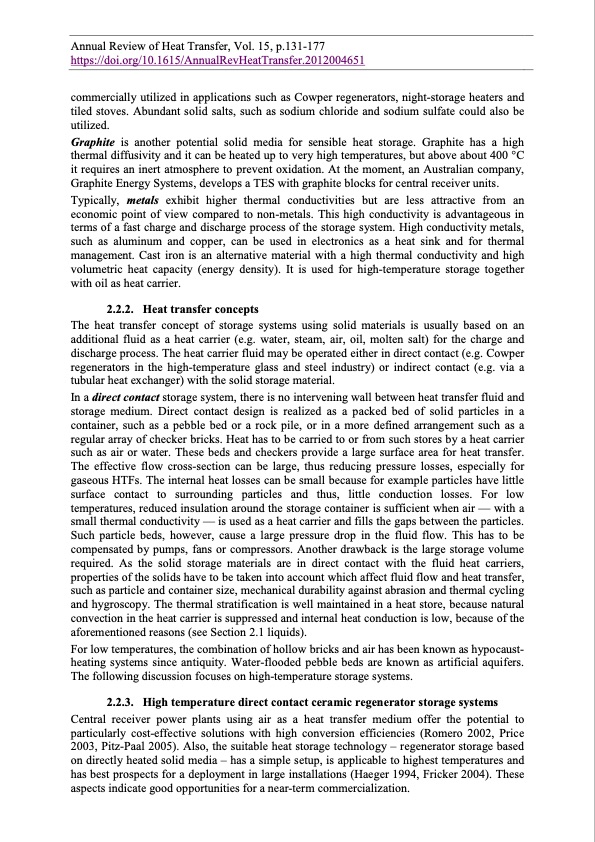
PDF Publication Title:
Text from PDF Page: 019
Annual Review of Heat Transfer, Vol. 15, p.131-177 https://doi.org/10.1615/AnnualRevHeatTransfer.2012004651 commercially utilized in applications such as Cowper regenerators, night-storage heaters and tiled stoves. Abundant solid salts, such as sodium chloride and sodium sulfate could also be utilized. Graphite is another potential solid media for sensible heat storage. Graphite has a high thermal diffusivity and it can be heated up to very high temperatures, but above about 400 °C it requires an inert atmosphere to prevent oxidation. At the moment, an Australian company, Graphite Energy Systems, develops a TES with graphite blocks for central receiver units. Typically, metals exhibit higher thermal conductivities but are less attractive from an economic point of view compared to non-metals. This high conductivity is advantageous in terms of a fast charge and discharge process of the storage system. High conductivity metals, such as aluminum and copper, can be used in electronics as a heat sink and for thermal management. Cast iron is an alternative material with a high thermal conductivity and high volumetric heat capacity (energy density). It is used for high-temperature storage together with oil as heat carrier. 2.2.2. Heat transfer concepts The heat transfer concept of storage systems using solid materials is usually based on an additional fluid as a heat carrier (e.g. water, steam, air, oil, molten salt) for the charge and discharge process. The heat carrier fluid may be operated either in direct contact (e.g. Cowper regenerators in the high-temperature glass and steel industry) or indirect contact (e.g. via a tubular heat exchanger) with the solid storage material. In a direct contact storage system, there is no intervening wall between heat transfer fluid and storage medium. Direct contact design is realized as a packed bed of solid particles in a container, such as a pebble bed or a rock pile, or in a more defined arrangement such as a regular array of checker bricks. Heat has to be carried to or from such stores by a heat carrier such as air or water. These beds and checkers provide a large surface area for heat transfer. The effective flow cross-section can be large, thus reducing pressure losses, especially for gaseous HTFs. The internal heat losses can be small because for example particles have little surface contact to surrounding particles and thus, little conduction losses. For low temperatures, reduced insulation around the storage container is sufficient when air — with a small thermal conductivity — is used as a heat carrier and fills the gaps between the particles. Such particle beds, however, cause a large pressure drop in the fluid flow. This has to be compensated by pumps, fans or compressors. Another drawback is the large storage volume required. As the solid storage materials are in direct contact with the fluid heat carriers, properties of the solids have to be taken into account which affect fluid flow and heat transfer, such as particle and container size, mechanical durability against abrasion and thermal cycling and hygroscopy. The thermal stratification is well maintained in a heat store, because natural convection in the heat carrier is suppressed and internal heat conduction is low, because of the aforementioned reasons (see Section 2.1 liquids). For low temperatures, the combination of hollow bricks and air has been known as hypocaust- heating systems since antiquity. Water-flooded pebble beds are known as artificial aquifers. The following discussion focuses on high-temperature storage systems. 2.2.3. High temperature direct contact ceramic regenerator storage systems Central receiver power plants using air as a heat transfer medium offer the potential to particularly cost-effective solutions with high conversion efficiencies (Romero 2002, Price 2003, Pitz-Paal 2005). Also, the suitable heat storage technology – regenerator storage based on directly heated solid media – has a simple setup, is applicable to highest temperatures and has best prospects for a deployment in large installations (Haeger 1994, Fricker 2004). These aspects indicate good opportunities for a near-term commercialization.PDF Image | Annual Review of Heat Transfer

PDF Search Title:
Annual Review of Heat TransferOriginal File Name Searched:
2012_Thermal_Energy_Storage_Materials_and_Systems.pdfDIY PDF Search: Google It | Yahoo | Bing
Turbine and System Plans CAD CAM: Special for this month, any plans are $10,000 for complete Cad/Cam blueprints. License is for one build. Try before you buy a production license. More Info
Waste Heat Power Technology: Organic Rankine Cycle uses waste heat to make electricity, shaft horsepower and cooling. More Info
All Turbine and System Products: Infinity Turbine ORD systems, turbine generator sets, build plans and more to use your waste heat from 30C to 100C. More Info
CO2 Phase Change Demonstrator: CO2 goes supercritical at 30 C. This is a experimental platform which you can use to demonstrate phase change with low heat. Includes integration area for small CO2 turbine, static generator, and more. This can also be used for a GTL Gas to Liquids experimental platform. More Info
Introducing the Infinity Turbine Products Infinity Turbine develops and builds systems for making power from waste heat. It also is working on innovative strategies for storing, making, and deploying energy. More Info
Need Strategy? Use our Consulting and analyst services Infinity Turbine LLC is pleased to announce its consulting and analyst services. We have worked in the renewable energy industry as a researcher, developing sales and markets, along with may inventions and innovations. More Info
Made in USA with Global Energy Millennial Web Engine These pages were made with the Global Energy Web PDF Engine using Filemaker (Claris) software.
Sand Battery Sand and Paraffin for TES Thermo Energy Storage More Info
| CONTACT TEL: 608-238-6001 Email: greg@infinityturbine.com | RSS | AMP |